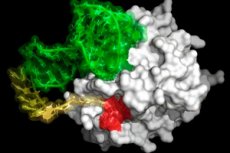New publications
New molecule mimics the anticoagulation action of blood-sucking organisms
Last reviewed: 02.07.2025

All iLive content is medically reviewed or fact checked to ensure as much factual accuracy as possible.
We have strict sourcing guidelines and only link to reputable media sites, academic research institutions and, whenever possible, medically peer reviewed studies. Note that the numbers in parentheses ([1], [2], etc.) are clickable links to these studies.
If you feel that any of our content is inaccurate, out-of-date, or otherwise questionable, please select it and press Ctrl + Enter.

Nature has given ticks, mosquitoes and leeches a quick way to prevent blood from clotting so they can extract their food from their host. Now the key to this method has been harnessed by a team of Duke University researchers as a potential anticoagulant that could be used as an alternative to heparin during angioplasty, dialysis, surgery and other procedures.
In a paper published in the journal Nature Communications, the researchers describe a synthetic molecule that mimics the effects of compounds in the saliva of blood-sucking creatures. Importantly, the new molecule can also be quickly neutralized, allowing clotting to resume if needed after treatment.
“Biology and evolution have evolved a highly effective anticoagulation strategy several times,” said senior author Bruce Sullenger, PhD, a professor in the departments of surgery, cell biology, neurosurgery, and cancer pharmacology and biology at Duke University School of Medicine. “This is the perfect model.”
Sullenger and his colleagues at Duke University and the University of Pennsylvania, including lead author Haixiang Yu, PhD, a member of Sullenger’s lab, started with the observation that all blood-sucking organisms have developed a similar system for inhibiting blood clotting. The anticoagulant in their saliva uses a two-phase process: It binds to the surface of specific clotting proteins in the host’s blood and then penetrates the protein’s core to temporarily inactivate clotting while they feed.
The blood-sucking organisms target different proteins among the more than two dozen molecules involved in clotting, but the research team focused on developing molecules that target thrombin and factor Xa in human blood, achieving biphasic anticoagulant function against these proteins.
The next challenge was to develop a way to reverse the process, which is necessary for clinical use to ensure that people do not bleed. By fully understanding the activation mechanism, the researchers were able to create an antidote that quickly reverses clotting.
"We think this approach may be safer for patients and cause less inflammation," Yu said.
Another advantage is that it is a synthetic molecule, unlike the current clinical standard for the last 100 years, heparin. Heparin is derived from pig intestines, which requires a huge farming infrastructure that generates pollution and greenhouse gases.
“This is part of my new passion — improving blood clotting controls to help patients while also taking climate concerns into account,” Sullenger said. “The medical community is starting to realize that there is a big problem here and we need to find alternatives to using animals to make drugs.”
